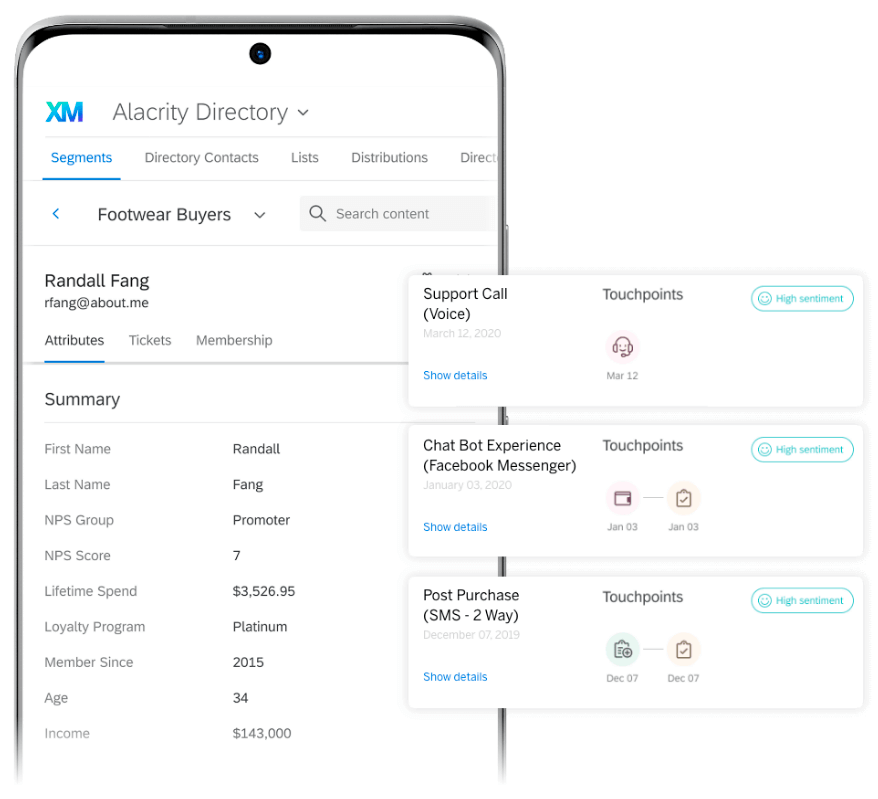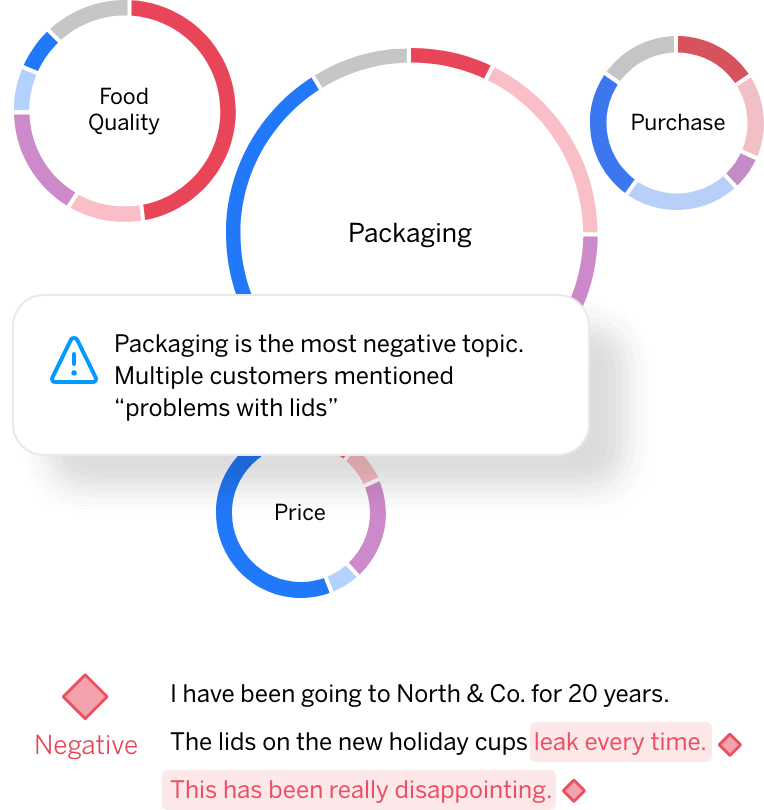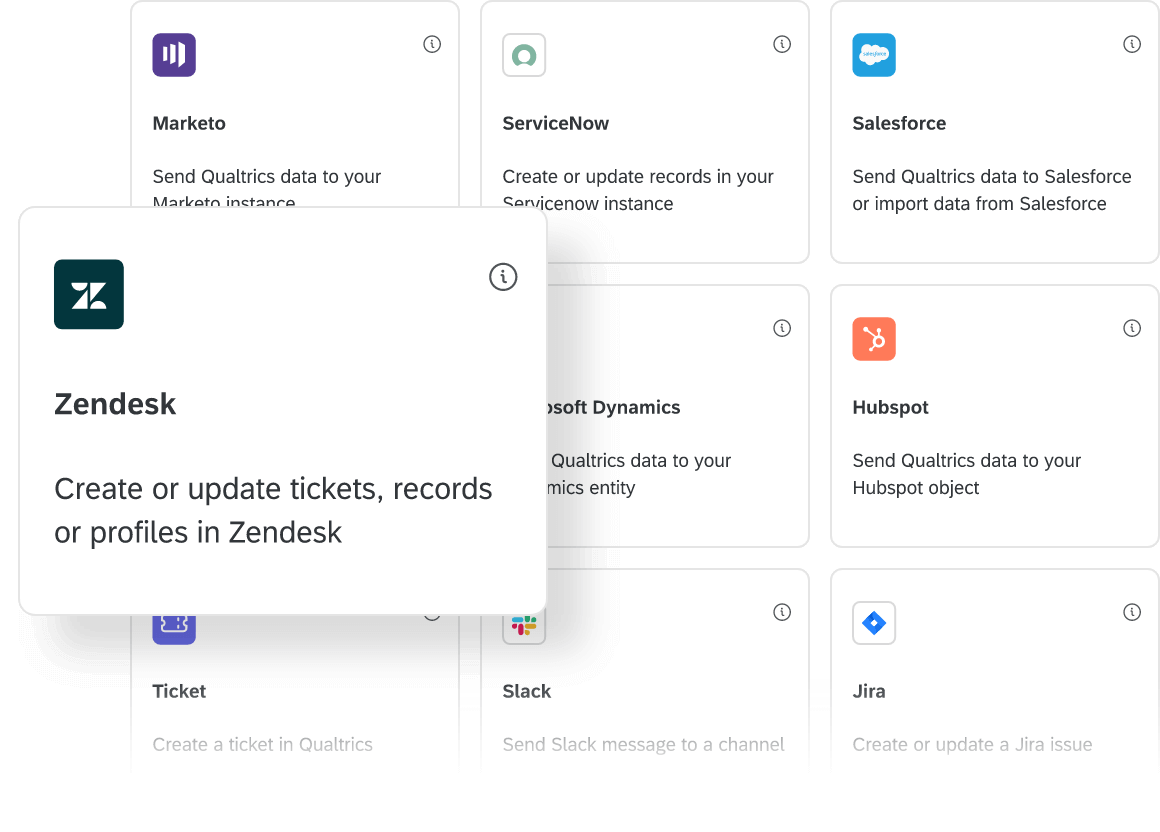Two disciplines. One platform.
Experience
Design
Design breakthrough products, services,
cultures, and brands
Experience
Improvement
Continuously improve customer, employee,
product, and brand experiences
Experience Design
Uncover and deliver what customers and employees want next––breakthrough experiences that shift markets, define brands, establish cultures, and attract new customers.
Experience Improvement
Continuously evaluate each product, service, process, or system - and make real-time changes to ensure that your offerings not only stay highly competitive, but delight and disrupt.
How experience management works
1
Understand customer segments and their needs. Design breakthrough experiences for target segments
2
Engage key segments using the channels and moments they prefer
3
Collect, analyse, and share feedback with managers and teams so they understand how customers and employees feel
4
Determine and take the best actions for improvement. Then, automate actions using experience workflows
5
Save and share workflows with other teams, departments, or locations
Design + improve the four core experiences
Experience Design
Re-think and re-invent the experiences you deliver to your customers
- What’s the ideal process for someone who loses their card?
- What channels do our customers prefer to use when looking for support?
- How would a new video chat feature impact customer loyalty?
- Which customer segments are most likely to use video chat?
Experience Improvement
Hunt down and close experience gaps to continually exceed customer expectations
- Which products do our agents need better training on?
- Which common issues can we solve automatically to reduce support calls?
- Which touchpoints in the customer journey have the lowest satisfaction levels?
- How can we identify customers who need support and reach out proactively?
Experience Design
Design a workplace experience that drives engagement and productivity
- Of all the options, which employee benefits actually impact retention?
- Which onboarding experiences will lead to immediate engagement?
- Which elements of our culture do we need to re-think for next year?
- Which IT processes can we eliminate or improve to drive productivity?
Experience Improvement
Continually improve the experience and respond to the changing needs of your people
- Which teams have the lowest engagement scores?
- Which managers need coaching, and about what?
- Which new benefits should we add for the year ahead?
- Where are their skills gaps and what kind of training do employees need next?
Experience Design
Uncover unmet market needs and design the products people want next.
- Which segment feels the most underserved: enterprise or consumer?
- Which feature/price combination will encourage consumers to switch to our router?
- Which security features are mission critical for this segment?
- How will price affect perception of quality?
Experience Improvement
Continuously iterate and improve your products to stay highly competitive
- Which bugs are customers experiencing and how should we prioritise?
- How does pricing need to change to stay competitive?
- Which new features should be prioritised in the next firmware update?
- Why are users not opting-in for premium support with this model?
Experience Design
Drive brand loyalty with new, disruptive experiences that delight
- How do consumers view our electric car offering compared to competitors?
- How do target consumers prioritise environmentalism or vehicle appearance?
- How deeply can we discount the previous model without affecting brand perception?
- Which specific feature should we highlight in our new TV spot?
Experience Improvement
Respond to changes in your market through continuous improvement to the brand experience
- Did the last campaign measurably increase awareness?
- Where do we stack in brand perception on safety related to competitors?
- How should we adjust our messaging on the autonomous driving feature?
- How is the extended warranty upsell experience affecting brand perception?
The operating system for the experience economy
Qualtrics XM is the backbone of the world’s most successful companies. Our secure, agile, easy-to-use platform is a common framework for entire companies to design and improve customer and employee experiences - and to consistently drive innovation in a world where people demand ever more from products, brands, and experiences.
1
Listen + Remember
Get to know every stakeholder so you can deliver hyper-personalised experiences. When someone says something about your company you can capture it and store it in the Experience Management Platform™. Over time, you’ll build up detailed profiles of your customers, employees, and any other stakeholder to know exactly what they like, need, and how every interaction with your company made them feel.
A single system of record for every interaction across the organisation.
Learn More
2
Process + Understand
See which actions to take next, thanks to a powerful analytics engine that works in the background 24/7. Experience Management takes all your data on what people said, how they feel, and what they did and uses it to model the impact of your actions. The end result is recommendations delivered in plain language to people across the business so they know exactly what to do to design and improve the experience.
Powerful, predictive analytics that make sense of your entire dataset, and proactively recommend the actions to take next.
Learn More
3
Build a culture of action
Make taking action an automatic response, right across the organisation. From triggering actions that impact millions of customers to take place automatically, to alerting the right person in the organisation to what they need to do next, it makes taking action scalable.
Intelligent, customisable workflows automatically alert the right people, and trigger actions in every part of the organisation.
Learn More
Frequently asked questions
Experience Management (XM) is a holistic approach to listening to the voice of customers, employees, and other stakeholders and using the knowledge, understanding and insights to design and improve the experiences you deliver. It’s used by organisations to launch new experiences based on powerful market research to uncover unmet customer and employee needs, and then to continually optimise those experiences as their market and their stakeholders’ needs change.
Experience Management is for everyone in the organisation. From product and marketing teams, to customer care, HR, and frontline staff, everyone in the workplace today is responsible for designing and delivering experiences. Experience management is designed to provide everyone across the organisation with detailed insights and recommended actions to play their part in delivering world-class experiences to both customers and employees. With integrations into your existing workplace technology, it plugs in to the fabric of the organisation, to make taking action to design and improve the experience an automatic response right across the organisation.
How long have you got?! When you deliver the experiences people need, they reward you with both their business and their loyalty. Our customers have used experience management to reduce churn, improve employee engagement, increase customer lifetime value, boost brand awareness, increase sales, and much more.
See our customer stories
Legacy customer experience programs tend to rely on limited feedback from a handful of customers — usually directly after a transaction or interaction — and are focused primarily on solving customer problems on a 1:1 level. They’re also focused on tracking a customer experience metric like CSAT or NPS. Experience management on the other hand is about listening to every customer, giving you a detailed understanding of every individual and then using that to take the right actions to exceed customer expectations. Where traditional customer experience is fairly resource-intensive to scale, experience management is easily scalable thanks to automated actions that mean once you’ve identified the best way to close the loop with a customer, you can automate it to take the same actions every time your organisation experiences a similar issue.